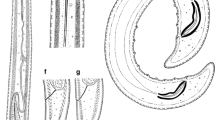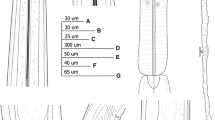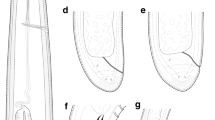Abstract
A new longidorid nematode, Longidorus asiaticus n. sp., is described and illustrated from a population extracted from soil associated with the movement of crape myrtle (Lagerstroemia indica) flowering bonsai trees imported from China into Italy. The new needle nematode is characterised by a small body size (2.74–3.52 mm), a bluntly-rounded lip region, ca 12 μm wide, continuous with body contour, amphidial fovea pocket-shape with posterior end rounded not bilobed, a moderately long and flexible odontostyle ca 85 μm long, stylet guiding ring located at ca 37 μm from anterior end, vulva almost equatorial (48–54 %), tail short, about 2/3 of its width, dorsally convex-conoid, with rounded terminus, with a c’ ratio ca 0.7, bearing two pairs of caudal pores and male absent. Integrative diagnosis was completed with molecular data obtained using D2-D3 expansion segments of 28S rDNA, ITS-rDNA, and partial 18S-rDNA. The phylogenetic relationships of this species with other Longidorus spp. using D2-D3 expansion segments, ITS and partial 18S-rDNA indicated that L. asiaticus n. sp. clustered together with L. hangzhouensis, Longidorus sp. JH-2014, and L. camelliae: all of them sharing a common Asiatic geographic origin.






Similar content being viewed by others
Notes
The species epithet refers to Asia, the geographic origin of the species
References
Amrei, S. B., Pedram, M., Pourjam, E., Elshishka, M., Ghaemi, R., & Peneva, V. (2013). New data on Longidorus aetnaeus Roca, Lamberti, Agostinelli & Vinciguerra, 1986 (Nematoda: Longidoridae) from Iran and Ajaria (Georgia). Systematic Parasitology, 85, 173–187.
Barsi, L., & Lamberti, F. (2001). Longidorus pius sp. n. (Nematoda: Longidoridae) from Macedonia. Nematologia Mediterranea, 29, 207–213.
Castillo, P., Vovlas, N., Subbotin, S., & Troccoli, A. (2003). A new root-knot nematode, Meloidogyne baetica n. sp. (Nematoda: Heteroderidae), parasitizing wild olive in Southern Spain. Phytopathology, 93, 1093–1102.
Chen, Q. W., Hooper, D. J., Loof, P. A. A., & Xu, J. H. (1997). A revised polytomous key for the identification of species of the genus Longidorus Micoletzky, 1922 (Nematoda: Dorylaimoidea). Fundamental and Applied Nematology, 20, 15–28.
Cherry, T., Szalanski, A. L., Todd, T. C., & Powers, T. O. (1997). The internal transcribed spacer region of Belonolaimus (Nemata: Belonolaimidae). Journal of Nematology, 29, 23–29.
Coolen, W. A. (1979). Methods for extraction of Meloidogyne spp. and other nematodes from roots and soil. In F. Lamberti & C. E. Taylor (Eds.), Root-knot nematodes (Meloidogyne species). Systematics, biology and control (pp. 317–329). New York: Academic.
Coomans, A. (1996). Phylogeny of the Longidoridae. Russian Journal of Nematology, 4, 51–60.
Darriba, D., Taboada, G. L., Doallo, R., & Posada, D. (2012). jModelTest 2: more models, new heuristics and parallel computing. Nature Methods, 9, 772.
De Luca, F., Archidona-Yuste, A., Troccoli, A., Fanelli, E., Vovlas, N., Trisciuzzi, N., & Castillo, P. (2014). Redescription and molecular characterisation of Xiphinema barense Lamberti et al., 1986 (Nematoda: Longidoridae) from wild olive trees in southern Italy. Nematology, 16, 1079–1089.
Decraemer, W., & Coomans, A. (2007). Revision of some species of the genus Paralongidorus sensu Siddiqi et al. (1993), with a discussion on the relationships within the family Longidoridae (Nematoda: Dorylaimida). Nematology, 9, 643–662.
Decraemer, W., & Robbins, R. T. (2007). The who, what and where of Longidoridae and Trichodoridae. Journal of Nematology, 39, 295–297.
Dhanam, M., & Jairajpuri, M. S. (1997). Three new species of longidorid nematodes (Dorylaimida) from Malnad Tracts of Karnataka, India. International Journal of Nematology, 7, 62–67.
Esser, R. P. (1960). Three additional species in the genus Hemicriconemoides Chitwood and Birchfield 1957 (Nemata: Tylenchida). Nematologica, 5, 64–71.
Flegg, J. J. M. (1967). Extraction of Xiphinema and Longidorus species from soil by a modification of Cobb’s decanting and sieving technique. Annals of Applied Biology, 60, 429–437.
Golden, A. M. (1979). Descriptions of Meloidogyne camelliae n. sp. and M. querciana n. sp. (Nematoda: Meloidogynidae), with SEM and host-range observations. Journal of Nematology, 11, 175–189.
Gutiérrez-Gutiérrez, C., Palomares-Rius, J. E., Cantalapiedra-Navarrete, C., Landa, B. B., & Castillo, P. (2010). Prevalence, polyphasic identification, and molecular phylogeny of dagger and needle nematodes infesting vineyards in southern Spain. European Journal of Plant Pathology, 129, 427–453.
Gutiérrez-Gutiérrez, C., Cantalapiedra-Navarrete, C., Montes-Borrego, M., Palomares-Rius, J. E., & Castillo, P. (2013a). Molecular phylogeny of the nematode genus Longidorus (Nematoda: Longidoridae) with description of three new species. Zoological Journal of the Linnean Society, 167, 473–500.
Gutiérrez-Gutiérrez, C., Cantalapiedra-Navarrete, C., Remesal, E., Palomares-Rius, J. E., Navas-Cortés, J. A., & Castillo, P. (2013b). New insight into the identification and molecular phylogeny of dagger nematodes of the genus Xiphinema (Nematoda: Longidoridae) with description of two new species. Zoological Journal of the Linnean Society, 169, 548–579.
Hall, T. A. (1999). BioEdit: a user-friendly biological sequence alignment editor and analysis program for Windows 95/98NT. Nucleic Acids Symposium Series, 41, 95–98.
He, Y., Subbotin, S., Rubtsova, T. V., Lamberti, F., Brown, D. J. F., & Moens, M. (2005). A molecular phylogenetic approach to Longidoridae (Nematoda: Dorylaimida). Nematology, 7, 111–124.
Heyns, J. (1965). New species of the genera Paralongidorus and Longidorus (Nematoda: Dorylaimoidea) from South Africa. South African Journal of Agricultural Science, 8, 863–874.
Hooper, D. J. (1961). A redescription of Longidorus elongatus (De Man, 1876) Thorne Swanger, 1936, (Nematoda, Dorylaimidae) and descriptions of five new species of Longidorus from Great Britain. Nematologica, 6, 237–257.
Jairajpuri, M. S., & Ahmad, W. (1992). Dorylaimida. Freeliving, predaceous and plant-parasitic nematodes. New Delhi: Oxford & IBH Publishing Co.. 458 pp.
Karssen, G., & Van Aelst, A. (1999). Description of Cryphodera brinkmani n. sp. (Nematoda: Heteroderidae), a parasite of Pinus thunbergii Parlatore from Japan, including a key to the species of the genus Cryphodera Colbran, 1966. Nematology, 1, 121–130.
Katoh, K., Misawa, K., Kuma, K., & Miyata, T. (2002). MAFFT: a novel method for rapid multiple sequence alignment based on fast Fourier transform. Nucleic Acids Resources, 30, 3059–3066.
Khan, F. A., & Khan, A. M. (1972). Studies on distribution and population of Longidorus brevicaudatus, Xiphinema basiri and X. americanum in Uttar Pradesh and Rajasthan with description of Longidorus psidii n. sp. (Nematoda: Dorylaimoidea). Indian Phytopathology, 25, 269–274.
Khan, E., Saha, M., & Seshadri, A. R. (1972). Plant parasitic nematodes from Kumaon Hills, India. I. Two new species of Paralongidorus (Nematoda: Longidoridae). Nematologica, 18, 38–43.
Lal, A., & Mathur, A. K. (1987). Nematodes in the rhizosphere of date palm, with description of Longidoroides bikanerensis sp. n. (Nematoda: Dorylaimoidea). Date Palm Journal, 5, 208–214.
Loof, P. A. A., & Chen, Q. (1999). A revised polytomous key for the identification of the species of the genus Longidorus Micoletzky, 1922 (Nematoda: Dorylaimoidea). Supplement 1. Nematology, 1, 55–59.
McCullough, D. G., Work, T. T., Cavey, J. F., Liebhold, A. M., & Marshall, D. (2006). Interceptions of nonindigenous plant pests at US ports of entry and border crossings over a 17-year period. Biological Invasions, 8, 611–630.
Merny, G. (1966). Nematodes d’Afrique tropicale: un nouveau Paratylenchus (Criconematidae), deux nouveaux Longidorus et observations sur Longidorus laevicapitatus Williams, 1959 (Dorylaimidae). Nematologica, 12, 385–395.
Micoletzky, H. (1922). Die Freilebenden Erd-Nematoden. Archiv für Naturgeschichte, Berlin A, 87, 1–650.
Nunn, G.B. (1992). Nematode molecular evolution. Ph.D. Thesis, University of Nottingham, Nottingham, UK.
Page, R. D. (1996). TreeView: an application to display phylogenetic trees on personal computers. Computer Applications in the Biosciences, 12, 357–358.
Palomares-Rius, J. E., Subbotin, S. A., Landa, B. B., Vovlas, N., & Castillo, P. (2007). Description and molecular characterisation of Paralongidorus litoralis sp. n. and P. paramaximus Heyns, 1965 (Nematoda: Longidoridae) from Spain. Nematology, 10, 87–101.
Quénéhervé, P., Topart, P., & Poliakoff, F. (1998). Interception of nematodes on imported bonsai in Martinique. Nematropica, 28, 101–105.
Ronquist, F., & Huelsenbeck, J. P. (2003). MRBAYES3: Bayesian phylogenetic inference under mixed models. Bioinformatics, 19, 1572–1574.
Seinhorst, J. W. (1966). Killing nematodes for taxonomic study with hot f.a. 4:1. Nematologica, 12, 178.
Siddiqi, M. R., Baujard, P., & Mounport, D. (1993). Description of Paratylenchus pernoxius sp. n. and Paralongidorus duncani sp. n. from Senegal, and synonymization of Longidoroides with Paralongidorus. Afro-Asian Journal of Nematology, 3, 81–89.
Subbotin, S., Rogozhin, E., & Chizhov, V. (2014). Molecular characterisation and diagnostics of some Longidorus species (Nematoda: Longidoridae) from Russia and other countries using rRNA genes. European Journal of Plant Pathology, 138, 377–390.
Swofford, D.L. (2003). PAUP*. Phylogenetic Analysis using Parsimony (*and other methods), version 4.0b 10, Sunderland, MA, USA, Sinauer Associates.
Taylor, C. E., & Brown, D. J. F. (1997). Nematode vectors of plant viruses. Wallingford: CABI. 296 pp.
Trisciuzzi, N., Troccoli, A., Vovlas, N., Cantalapiedra-Navarrete, C., Palomares-Rius, J. E., & Castillo, P. (2014). Detection of the camellia root-knot nematode Meloidogyne camelliae Golden in Japanese camellia bonsai imported into Italy: integrative diagnosis, parasitic habits and molecular phylogeny. European Journal of Plant Pathology, 138, 231–235.
Van den Berg, E., Tiedt, L. R., Inserra, R. N., Stanley, J. D., Vovlas, N., Palomares-Rius, J. E., Castillo, P., & Subbotin, S. A. (2014). Morphological and molecular characterisation of some Hemicriconemoides species (Nematoda: Criconematidae) together with a phylogeny of the genus. Nematology, 16, 519–553.
Vovlas, N., Trisciuzzi, N., Troccoli, A., Luca, F., Cantalapiedra-Navarrete, C., & Castillo, P. (2013). Integrative diagnosis and parasitic habits of Cryphodera brinkmani a non-cyst forming heteroderid nematode intercepted on Japanese white pine bonsai trees imported into Italy. European Journal of Plant Pathology, 135, 717–726.
Vrain, T. C., Wakarchuk, D. A., Levesque, A. C., & Hamilton, R. I. (1992). Intraspecific rDNA restriction fragment length polymorphism in the Xiphinema americanum group. Fundamental and Applied Nematology, 15, 563–573.
Xu, J., & Cheng, H. (1992). Longidorus litchii n. sp. and L. henanus n. sp. (Nemata: Longidoridae) from China. Fundamental and Applied Nematology, 15, 517–523.
Xu, J., & Hooper, D. J. (1990). Observations on some species of Longidorus (Nematoda: Longidoridae) from Jiangsu Province, China, with a description of Longidorus jiangsuensis n. sp. Revue de Nématologie, 13, 323–330.
Yagita, H., & Komuro, Y. (1972). Transmission of mulberry ringspot virus by Longidorus martini Merny. Annals of the Phytopathological Society of Japan, 38, 275–283.
Zheng, J., Peneva, V., & Brown, D. J. (2000). Longidorus camelliae n. sp. (Nematoda: Longidoridae) associated with ornamental cultivars of Camellia japonica L. growing in a nursery at Fuyang, Zhejiang Province, eastern China. Systematic Parasitology, 47, 119–125.
Zheng, J., Peng, D., Robbins, R. T., & Brown, D. J. F. (2001). Description of Longidorus hangzhouensis sp. n. (Nemata: Longidoridae) from Zhejiang province, new geographical records of L. henanus Xu & Cheng, 1992, and an identification key for Longidorus species occurring in China. Nematology, 3, 219–227.
Acknowledgments
This research was partially supported by grant AGR-136 from ‘Consejería de Economía, Innvovación y Ciencia’ from Junta de Andalucía, and Union Europea, Fondo Europeo de Desarrollo regional, “Una manera de hacer Europa”. Authors thank J.E. Palomares-Rius and C. Cantalapiedra-Navarrete (IAS-CSIC) for critical reading of the manuscript before submission; and J. Martín Barbarroja and G. León Ropero from IAS-CSIC, and V. Radicci from IPSP-CNR for the excellent technical assistance. Authors thank all officers of Apulian Phytosanitary control service of Bari, Italy; and the commercial nursery for helping with detection and sanitation of this nematode.
Author information
Authors and Affiliations
Corresponding author
Rights and permissions
About this article
Cite this article
Trisciuzzi, N., Archidona-Yuste, A., Troccoli, A. et al. Description of a new needle nematode, Longidorus asiaticus n. sp. (Nematoda: Longidoridae), from the rhizosphere of crape myrtle (Lagerstroemia indica) bonsai trees imported into Italy from China. Eur J Plant Pathol 143, 567–580 (2015). https://doi.org/10.1007/s10658-015-0710-z
Accepted:
Published:
Issue Date:
DOI: https://doi.org/10.1007/s10658-015-0710-z




